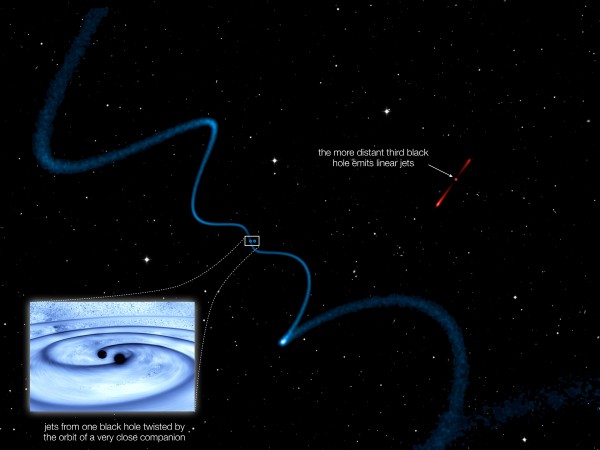.

Triple threat. In this artist's conception, the newfound black hole pair appears in the foreground, emitting jets of matter that have been colored blue, while a third black hole emits jets that have been colored red.
.
Astronomers staring across the universe have spotted a startling scene: three supermassive black holes orbiting close to one another, two of them just a few hundred light-years apart. The trio, housed in a pair of colliding galaxies, may help scientists hunting for ripples in spacetime known as gravitational waves.
Most giant galaxies harbor at their centers a supermassive black hole millions or billions of times as massive as the sun. If gas falls into the object, it can heat up and glow, turning the region just outside the black hole into a quasar—a brilliant galactic nucleus that can outshine the entire Milky Way.
Astronomer Roger Deane of the University of Cape Town in South Africa and his colleagues have been watching a particular quasar, known as SDSS J1502+1115, in the constellation Boötes. Other astronomers had found that the object, located 4.3 billion light-years from Earth, possessed two supermassive black holes, each the center of a large galaxy smashing into another. The black holes are at least 24,000 light-years apart.
Deane wanted to confirm their existence, so he used an intercontinental array of radio dishes that yields even sharper views than the Hubble Space Telescope. Lo and behold, one of the black holes turned out to be two. "We were incredibly surprised," says Deane, whose team reports its findings online today in Nature.
If the two black holes composing the newfound pair are equally distant from Earth, they're just 450 light-years apart and orbit each other every 4 million years. Triple black holes are rare, and the others discovered so far all feature black holes that are much farther apart. The new pair is the second "tightest" binary black hole known; a decade ago, other astronomers found two supermassive black holes separated by about 24 light-years.
"It's very good to see another object," says Greg Taylor of the University of New Mexico, Albuquerque, an astronomer who helped discover the first tight pair of black holes. With only one tight pair known, he says, it was difficult to assess how common even tighter black hole pairs are, which are crucial in the hunt for gravitational waves—a subtle type of radiation predicted by Einstein’s general theory of relativity. Two supermassive black holes orbiting just a fraction of a light-year apart should emit such waves and then give off a burst of them when the black holes merge.
No known binary black hole is tight enough to emit detectable gravitational radiation. But all orbiting black holes slowly spiral together, because they lose energy as their gravity kicks away stars. Deane says it’s encouraging that his team discovered the new pair after searching just six galaxies. "Either we got really, really lucky, or these are a lot more common than previously found," he says. So the hunt is on for tighter systems that emit gravitational waves.
In time, the nearby Andromeda galaxy will hit the Milky Way, and the supermassive black holes at each galaxy's center will form a duo that future observers can scrutinize. If you can wait a few billion years, says Harvard University astronomer Abraham Loeb, "there will be a binary [black hole] system right next door.”
Quelle: AAAS
4286 Views

